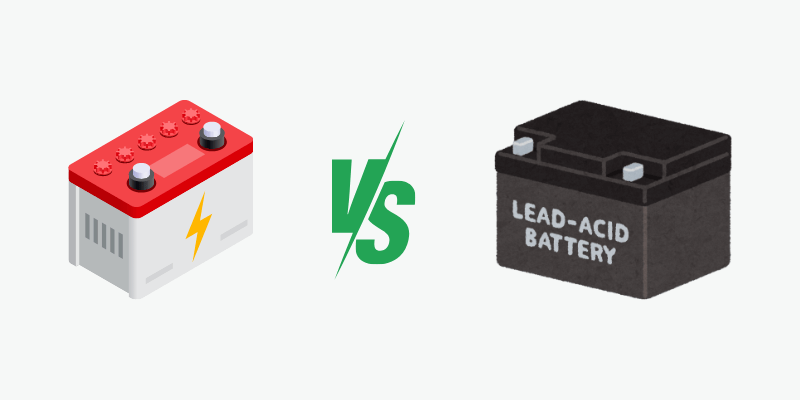Kľúčové informácie:
- Vyberte lítium-ión pre efektívnosť, dlhovekosť a prenosnosť; Olovo-kyselina pre počiatočné úspory nákladov a výkon chladného počasia.
Potrebujete výber medzi lítiami a olovenou kyselinou? Ste na správnom mieste.
Obaja sa používajú široko, ale slúžia rôznym aplikáciám a prichádzajú s vlastnými výhodami a nevýhodami.
Poďme to ďalej rozobrať.
Energetická hustota
Zaujímalo vás niekedy, koľko energie sa dá uložiť v danom priestore v týchto batériách? To sa meria hustotou energie.
Lítium-iónové batérie uberajte sa a dáte vám okolo 50-260 WH/kg, zatiaľ čo batérie olovo-kyseliny zvyčajne ponúkajú medzi 30-50 WH/kg.
Hmotnosť
Lítiové batérie sú výrazne ľahšie ako ich náprotivky z olovených kyselín, pričom vážia až o 60% menej. Predstavte si mobilitu a prenosnosť!
Účinnosť
Lítium-iónové batérie sa opäť posunú k efektívnosti.
Ich účinnosť náboja a výboja často presahuje 95% v porovnaní so 70-85% rozsahom batérií olovnatej kyseliny.
Nie je to konzistentnosť a spoľahlivosť, čo všetci hľadáte?
Čas nabíjania
Ako rýchlo sa tieto batérie nabíjajú?
Aj tu žiaria lítium-iónové batérie a potrebujú len 3-5 hodín na úplné nabíjanie.
Ich náprotivky oloveného kyseliny však potrebujú o niečo viac času a trvať 8-12 hodín na plný poplatok.
Rýchlosť výtoku a hĺbka
Hĺbka vybíjania batérie naznačuje, koľko energie je možné vyčerpať bez poškodenia jej buniek.
Pri normálnom využití môže litium-iónová batéria využiť Viac ako 85% jeho kapacity.
Naopak, batéria olovo-kyselina by sa nemala vybíjať nad 50%, aby sa zachovala jeho životnosť.
Vysoká teplota
Lítiové batérie prekonávajú batérie SLA (zapečatená olovnaté kyseliny) pri vysokých teplotách, pričom účinne pôsobia na 60 ° C v porovnaní s 50 ° C SLA.
Pri 55 ° C trvá lítium dvakrát tak dlho, ako SLA pri teplote miestnosti.
Výkon
Teploty chladu môžu výrazne znížiť kapacitu batérie.
Pri hodnotení batérie na používanie chladu zvážte nabíjanie a vypúšťanie.
Lítiová batéria nebude nabíjať pod 32 ° F, zatiaľ čo SLA môže pri nízkych teplotách akceptovať nízky prúd.
Naopak, lítiové batérie majú v chladu vyššiu kapacitu vybíjania ako SLA. Lítiové batérie nemusia byť predávkované na prechladnutie, ale nabíjanie môže byť obmedzením. Pri 0 ° F sa lítium vypúšťa pri 70% svojej kapacity, zatiaľ čo SLA je na 45%.
Pri nabíjaní v chlade zvážte stav lítiovej batérie. Ak je nedávno prepustený, môže si zachovať dostatok tepla na prijatie náboja. Ak sa ochladí, nemusí sa nabíjať pod 32 ° F.
Životnosť batérie
Existujú Niekoľko typov lítiových batérií. V priemere môže lítiová batéria prekročiť 1 000 nabíjacích cyklov (batérie LifePO4 môžu trvať dokonca viac ako 3 000 cyklov so správnou údržbou).
Bohužiaľ, batérie kyseliny olova sú menej trvanlivé a trvajú iba 500 až 1 000 cyklov náboja všeobecne.
Viac cyklov = menej časté náhrady = nižšie náklady.
Nie je to hudba pre uši niekoho?
Ukladanie
Pre ukladanie, lítia zostáva vpred.
Ukladajú sa ľahšie a potrebujú menšiu údržbu ako batérie oloveného kyseliny.
náklady
Lítiové batérie môžu stojí viac vopred, ale vydržia dlhšie a fungujú lepšie, z dlhodobého hľadiska vám potenciálne šetrí peniaze.
Medzitým sú batérie olovo-kyselinové, ktoré sú spočiatku lacnejšie, ale často ich treba vymeniť častejšie, čo sa dá časom sčítavať.
Lítiové batérie Vs. Porovnanie olovených batérií
| Funkcia | Lítiové batérie | Olovené batérie |
|---|---|---|
| Hustota energie (WH/kg) | 120-180 | 28-40 |
| Hmotnosť | Až o 60% ľahší | Ťažší |
| Účinnosť (%) | Viac ako 95% | 70-85% |
| Čas nabíjania (hodiny) | 3-5 | 8-12 |
| Rýchlosť výtoku a hĺbka | Viac ako 85% kapacita | Nemalo by prekročiť 50% |
| Výkon vysokej teploty (° C) | Do 60 ° C s tepelným riadením | Do 50 ° C |
| Výkon | Vypúšťanie pri 70% pri 0 ° F, náboje pod 32 ° F s obmedzeniami | Prijíma nízke prúdové náboje pri nízkych teplotách, vypúšťa sa na 45% pri 0 ° F. |
| Životnosť batérie (cykly nabíjania) | Viac ako 1 000 | 300-500 |
| Skladovanie a údržba | Ľahšie ukladanie, menšia údržba | Vyžaduje sa viac údržby |
| náklady | Viac vopred, potenciálne nákladovo efektívna z dlhodobého hľadiska | Lacnejšie vopred, ale môže potrebovať častejšie náhrady |
Záver
Nakoniec, výber medzi lítiami a batériami na olova, závisí od vašich konkrétnych potrieb.
Lítiové batérie vynikajú v životnosť, hmotnosť a čas nabíjania, vďaka čomu sú ideálne pre vysokoúčinné aplikácie.
Naopak, batérie olovo-kyseliny fungujú dobre pri extrémnych teplotách a ponúkajú počiatočnú výhodu nákladov.
Pochopenie týchto rozdielov vás môže viesť k najlepším rozhodnutiam pre vaše požiadavky. Ktorá batéria teda napája váš ďalší projekt?
Súvisiace články:

